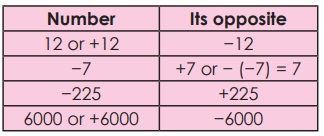Integers | Term 3 Chapter 2 | 6th Maths - Opposite of a number | 6th Maths : Term 3 Unit 2 : Integers
Chapter: 6th Maths : Term 3 Unit 2 : Integers
Opposite of a number
Opposite
of a number
The idea of opposite of a number is not a new one.
A few situations like, a man makes a profit of ₹ 500 or he loses ₹ 500 by selling
an article; credit and debit of ₹ 75000 in a cash transaction of a business are
‘opposite’ to each other.
Think about the situation
Suppose two rabbits R and S jump along a number
line (like) on the opposite sides of 0. Rabbit
R jumps 2 steps 3 times to the right of 0 and Rabbit S jumps 3 steps 2 times to
the left of 0 as shown in the figure below. Where will both of them stand on the
number line? Are they at equal distance from 0?

Clearly, the rabbit R stands at 6 and the rabbit
S stands at −6 on the number line. The distance from 0 to 6 on the number line is
6 units and the distance from 0 to −6 on the number line is also 6 units.The numbers
6 and −6 are at the same distance from 0 on the number line. That is, the rabbits
R and S stand at the same distance from 0, but in opposite directions.
Here, 6 and −6 are opposite to each other. That is, two numbers
that are at the same distance from 0 on the number line, but are on the opposite
sides of it, are opposite to each
other. For every positive integer, there is a corresponding negative integer and
vice versa. The opposite of each integer is shown in the figure.

Note
The opposite of the opposite of a
number is the number itself. For example –(–5) read as negative of negative 5 or
minus of minus 5 is equal to 5 itself.
Now, it is easy to write the opposite of the numbers
−7, 12, −225 and 6000. Note that, the opposite of a positive integer is negative,
and the opposite of a negative integer is positive, whereas the opposite of zero
is zero.

The “opposites” are naturally more convenient to
relate and understand with many of our daily-life situations like saving-spending,
credit-debit, height above-below, where
i) the saving is treated as positive and the spending
is treated as negative.
ii) a credit is considered positive whereas a debit
is considered negative.
iii) the height above the sea level is regarded as positive and the height below the sea level is regarded as negative.
Example 2
Represent the following situations as integers:
i) A gain of ₹1000 ii) 20°C below 0°C iii) 1990
BCE (BC) iv) A deposit of ₹15847 v) 10 kg
below normal weight
Solution
i) As gain is positive, ₹1000 is denoted as + ₹1000.
ii) 20°C below 0°C is denoted as −20°C.
iii) A year in BCE (BC) can be considered as a negative
number and a year in CE (AD) can be considered as a positive number. Hence, 1990
BCE (BC) can be represented as −1990.
iv) A deposit of ₹15847 is denoted as + ₹15847.
v) 10 kg
below normal weight is denoted as −10 kg.
Example 3
Using the number line, write the integer which is
5 more than −6.
Solution
From −6, we can move 5 units to its right to reach
−1 as shown in the figure.

Example 4
Find the
numbers on the number line that are at a distance of 3 units in the opposite directions
to −2.
Solution
From −2, we can move 3 units to the left and right
as shown in the figure.

The required numbers are: 1 on the right of −2 and
−5 to the left of −2.
Try these
1 Find the opposite of the following
numbers:
i) 55
ii) −300
iii) +5080
iv) −2500
v) 0
i) 55 opposite number − 55
ii) −300 opposite number + 300
iii) + 5080 opposite number − 5080
iv) −2500 opposite number + 2500
v) 0 − The number 0 is neither positive nor negative and hence
has no sign.
2 Represent the following situations
as integers.
i) A loss of ₹2000
ii) 2018 CE (AD)
iii) Fishes found at 60 m below the sea level
iv) 18°C below 0°C
v) Gaining 13 points
vi) A jet plane at a height of 2500
m
3 Suppose in a building, there are
2 basement floors. If the ground floor is denoted as zero, how can we represent
the basement floors?
Answer: − 2
DO YOU KNOW?
ISRO Scientists often find it convenient
to designate a given time as zero time and then refer to the time before and time
after as being negative and positive respectively. This practice is followed in
the launching of rockets. If the time to take off is 1 minute, then it is 1 minute
before the launch and hence denoted as -1 minute.

Related Topics